2015 NISSAN ROGUE SELECT Seat belt warning
[x] Cancel search: Seat belt warningPage 2 of 322
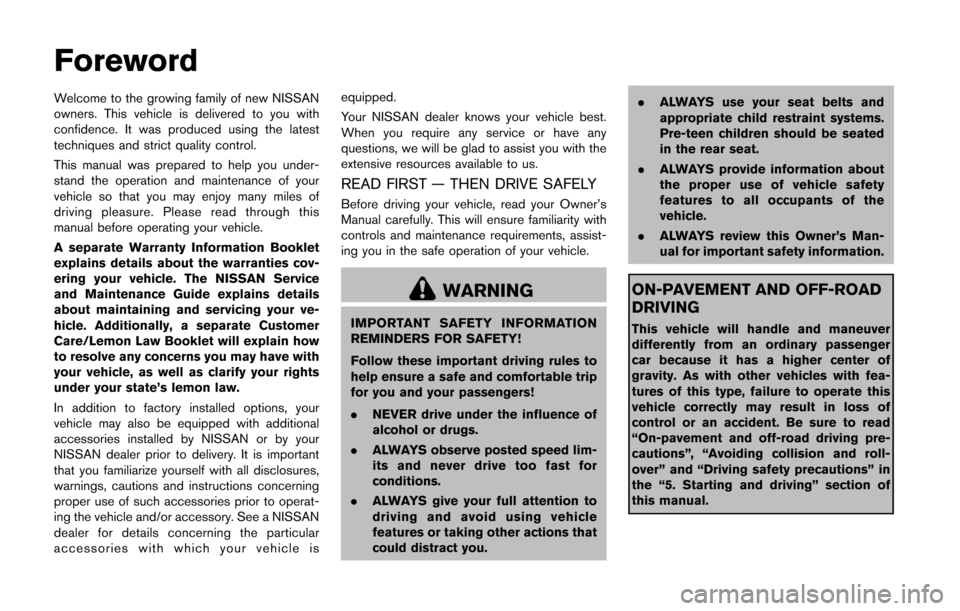
Welcome to the growing family of new NISSAN
owners. This vehicle is delivered to you with
confidence. It was produced using the latest
techniques and strict quality control.
This manual was prepared to help you under-
stand the operation and maintenance of your
vehicle so that you may enjoy many miles of
driving pleasure. Please read through this
manual before operating your vehicle.
A separate Warranty Information Booklet
explains details about the warranties cov-
ering your vehicle. The NISSAN Service
and Maintenance Guide explains details
about maintaining and servicing your ve-
hicle. Additionally, a separate Customer
Care/Lemon Law Booklet will explain how
to resolve any concerns you may have with
your vehicle, as well as clarify your rights
under your state’s lemon law.
In addition to factory installed options, your
vehicle may also be equipped with additional
accessories installed by NISSAN or by your
NISSAN dealer prior to delivery. It is important
that you familiarize yourself with all disclosures,
warnings, cautions and instructions concerning
proper use of such accessories prior to operat-
ing the vehicle and/or accessory. See a NISSAN
dealer for details concerning the particular
accessories with which your vehicle isequipped.
Your NISSAN dealer knows your vehicle best.
When you require any service or have any
questions, we will be glad to assist you with the
extensive resources available to us.
READ FIRST — THEN DRIVE SAFELY
Before driving your vehicle, read your Owner’s
Manual carefully. This will ensure familiarity with
controls and maintenance requirements, assist-
ing you in the safe operation of your
vehicle.
WARNING
IMPORTANT SAFETY INFORMATION
REMINDERS FOR SAFETY!
Follow these important driving rules to
help ensure a safe and comfortable trip
for you and your passengers!
.NEVER drive under the influence of
alcohol or drugs.
. ALWAYS observe posted speed lim-
its and never drive too fast for
conditions.
. ALWAYS give your full attention to
driving and avoid using vehicle
features or taking other actions that
could distract you. .
ALWAYS use your seat belts and
appropriate child restraint systems.
Pre-teen children should be seated
in the rear seat.
. ALWAYS provide information about
the proper use of vehicle safety
features to all occupants of the
vehicle.
. ALWAYS review this Owner’s Man-
ual for important safety information.
ON-PAVEMENT AND OFF-ROAD
DRIVING
This vehicle will handle and maneuver
differently from an ordinary passenger
car because it has a higher center of
gravity. As with other vehicles with fea-
tures of this type, failure to operate this
vehicle correctly may result in loss of
control or an accident. Be sure to read
“On-pavement and off-road driving pre-
cautions”, “Avoiding collision and roll-
over” and “Driving safety precautions” in
the “5. Starting and driving” section of
this manual.
Foreword
Page 10 of 322
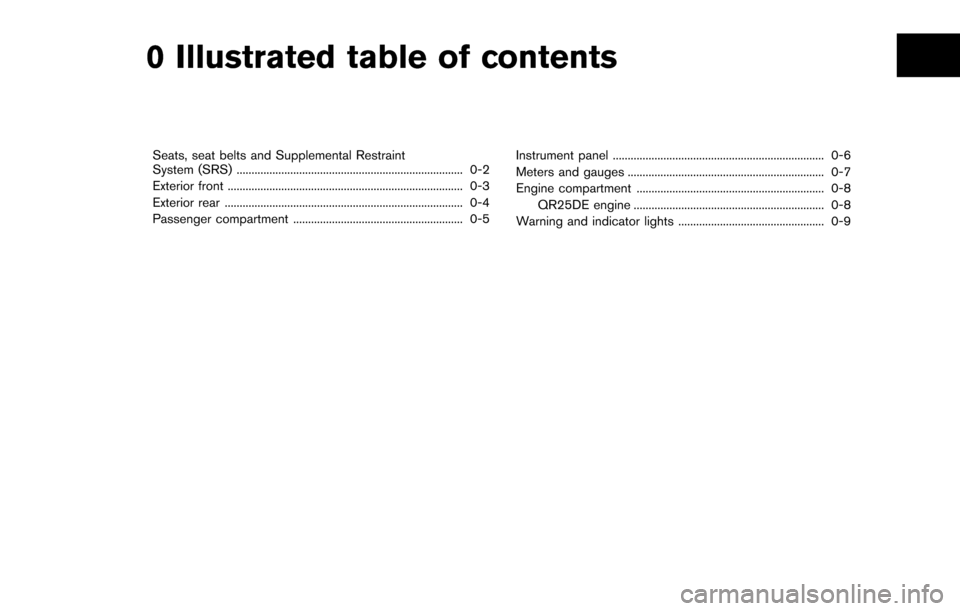
0 Illustrated table of contents
Seats, seat belts and Supplemental Restraint
System (SRS) ........................................................................\
.... 0-2
Exterior front ........................................................................\
....... 0-3
Exterior rear ........................................................................\
........ 0-4
Passenger compartment ......................................................... 0-5Instrument panel ....................................................................... 0-6
Meters and gauges .................................................................. 0-7
Engine compartment ............................................................... 0-8
QR25DE engine ................................................................ 0-8
Warning and indicator lights ................................................. 0-9
Page 18 of 322
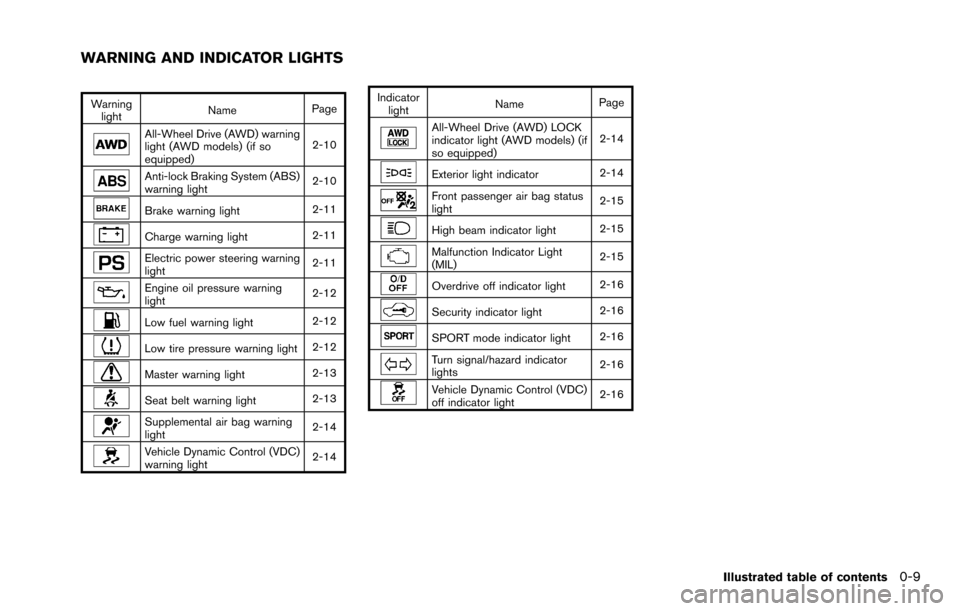
Warninglight Name
Page
All-Wheel Drive (AWD) warning
light (AWD models) (if so
equipped) 2-10
Anti-lock Braking System (ABS)
warning light
2-10
Brake warning light
2-11
Charge warning light2-11
Electric power steering warning
light2-11
Engine oil pressure warning
light2-12
Low fuel warning light
2-12
Low tire pressure warning light2-12
Master warning light2-13
Seat belt warning light2-13
Supplemental air bag warning
light2-14
Vehicle Dynamic Control (VDC)
warning light
2-14Indicator
light Name
Page
All-Wheel Drive (AWD) LOCK
indicator light (AWD models) (if
so equipped) 2-14
Exterior light indicator
2-14
Front passenger air bag status
light2-15
High beam indicator light
2-15
Malfunction Indicator Light
(MIL)2-15
Overdrive off indicator light
2-16
Security indicator light2-16
SPORT mode indicator light2-16
Turn signal/hazard indicator
lights2-16
Vehicle Dynamic Control (VDC)
off indicator light2-16
Illustrated table of contents0-9
WARNING AND INDICATOR LIGHTS
Page 20 of 322
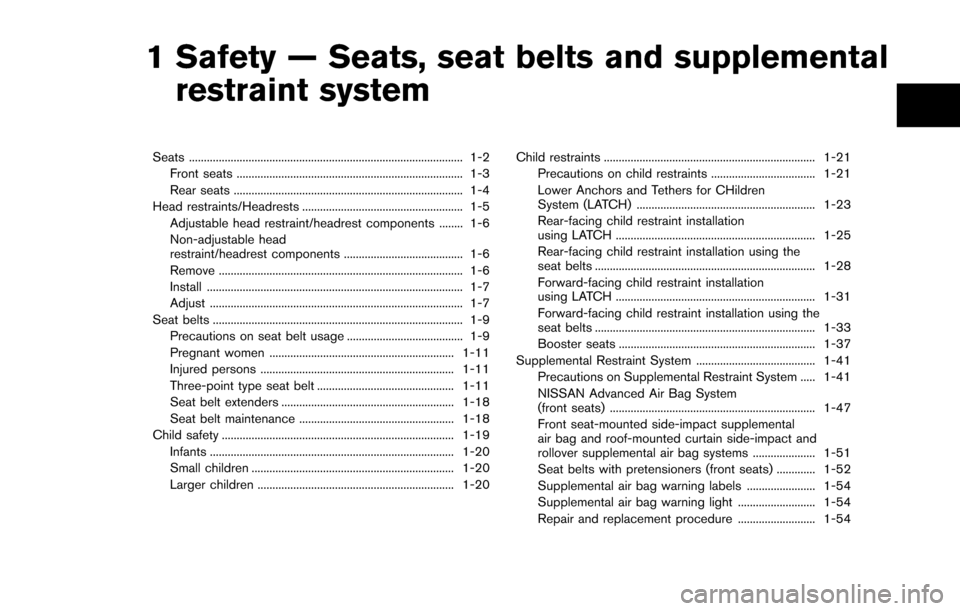
1 Safety — Seats, seat belts and supplementalrestraint system
Seats ........................................................................\
.................... 1-2
Front seats ........................................................................\
.... 1-3
Rear seats ........................................................................\
..... 1-4
Head restraints/Headrests ...................................................... 1-5 Adjustable head restraint/headrest components ........ 1-6
Non-adjustable head
restraint/headrest components ........................................ 1-6
Remove ........................................................................\
.......... 1-6
Install ........................................................................\
.............. 1-7
Adjust ........................................................................\
............. 1-7
Seat belts ........................................................................\
............ 1-9 Precautions on seat belt usage ....................................... 1-9
Pregnant women .............................................................. 1-11
Injured persons ................................................................. 1-11
Three-point type seat belt .............................................. 1-11
Seat belt extenders .......................................................... 1-18
Seat belt maintenance .................................................... 1-18
Child safety ........................................................................\
...... 1-19 Infants ........................................................................\
.......... 1-20
Small children .................................................................... 1-20
Larger children .................................................................. 1-20 Child restraints ....................................................................... 1-21
Precautions on child restraints ................................... 1-21
Lower Anchors and Tethers for CHildren
System (LATCH) ............................................................ 1-23
Rear-facing child restraint installation
using LATCH ................................................................... 1-25
Rear-facing child restraint installation using the
seat belts ........................................................................\
.. 1-28
Forward-facing child restraint installation
using LATCH ................................................................... 1-31
Forward-facing child restraint installation using the
seat belts ........................................................................\
.. 1-33
Booster seats .................................................................. 1-37
Supplemental Restraint System ........................................ 1-41 Precautions on Supplemental Restraint System ..... 1-41
NISSAN Advanced Air Bag System
(front seats) ..................................................................... 1-47
Front seat-mounted side-impact supplemental
air bag and roof-mounted curtain side-impact and
rollover supplemental air bag systems ..................... 1-51
Seat belts with pretensioners (front seats) ............. 1-52
Supplemental air bag warning labels ....................... 1-54
Supplemental air bag warning light .......................... 1-54
Repair and replacement procedure .......................... 1-54
Page 21 of 322
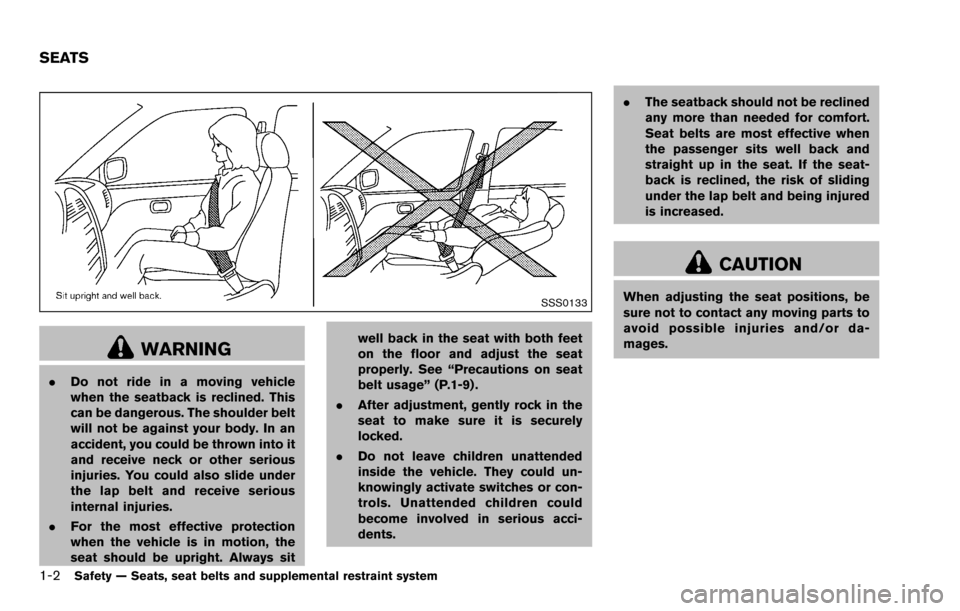
1-2Safety — Seats, seat belts and supplemental restraint system
SSS0133
WARNING
.Do not ride in a moving vehicle
when the seatback is reclined. This
can be dangerous. The shoulder belt
will not be against your body. In an
accident, you could be thrown into it
and receive neck or other serious
injuries. You could also slide under
the lap belt and receive serious
internal injuries.
. For the most effective protection
when the vehicle is in motion, the
seat should be upright. Always sit well back in the seat with both feet
on the floor and adjust the seat
properly. See “Precautions on seat
belt usage” (P.1-9) .
. After adjustment, gently rock in the
seat to make sure it is securely
locked.
. Do not leave children unattended
inside the vehicle. They could un-
knowingly activate switches or con-
trols. Unattended children could
become involved in serious acci-
dents. .
The seatback should not be reclined
any more than needed for comfort.
Seat belts are most effective when
the passenger sits well back and
straight up in the seat. If the seat-
back is reclined, the risk of sliding
under the lap belt and being injured
is increased.
CAUTION
When adjusting the seat positions, be
sure not to contact any moving parts to
avoid possible injuries and/or da-
mages.
SEATS
Page 23 of 322
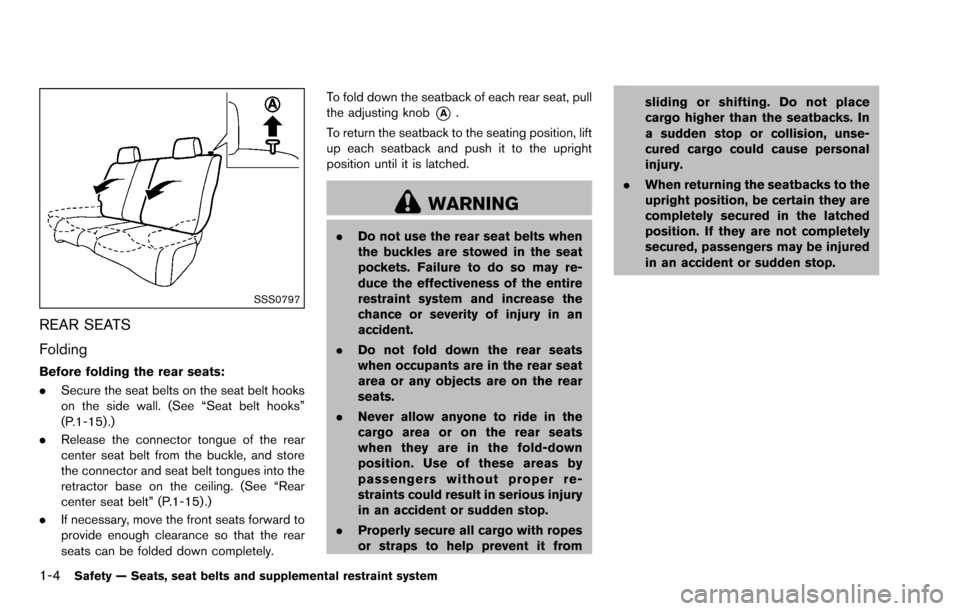
1-4Safety — Seats, seat belts and supplemental restraint system
SSS0797
REAR SEATS
Folding
Before folding the rear seats:
.Secure the seat belts on the seat belt hooks
on the side wall. (See “Seat belt hooks”
(P.1-15) .)
. Release the connector tongue of the rear
center seat belt from the buckle, and store
the connector and seat belt tongues into the
retractor base on the ceiling. (See “Rear
center seat belt” (P.1-15) .)
. If necessary, move the front seats forward to
provide enough clearance so that the rear
seats can be folded down completely. To fold down the seatback of each rear seat, pull
the adjusting knob
*A.
To return the seatback to the seating position, lift
up each seatback and push it to the upright
position until it is latched.
WARNING
. Do not use the rear seat belts when
the buckles are stowed in the seat
pockets. Failure to do so may re-
duce the effectiveness of the entire
restraint system and increase the
chance or severity of injury in an
accident.
. Do not fold down the rear seats
when occupants are in the rear seat
area or any objects are on the rear
seats.
. Never allow anyone to ride in the
cargo area or on the rear seats
when they are in the fold-down
position. Use of these areas by
passengers without proper re-
straints could result in serious injury
in an accident or sudden stop.
. Properly secure all cargo with ropes
or straps to help prevent it from sliding or shifting. Do not place
cargo higher than the seatbacks. In
a sudden stop or collision, unse-
cured cargo could cause personal
injury.
. When returning the seatbacks to the
upright position, be certain they are
completely secured in the latched
position. If they are not completely
secured, passengers may be injured
in an accident or sudden stop.
Page 24 of 322
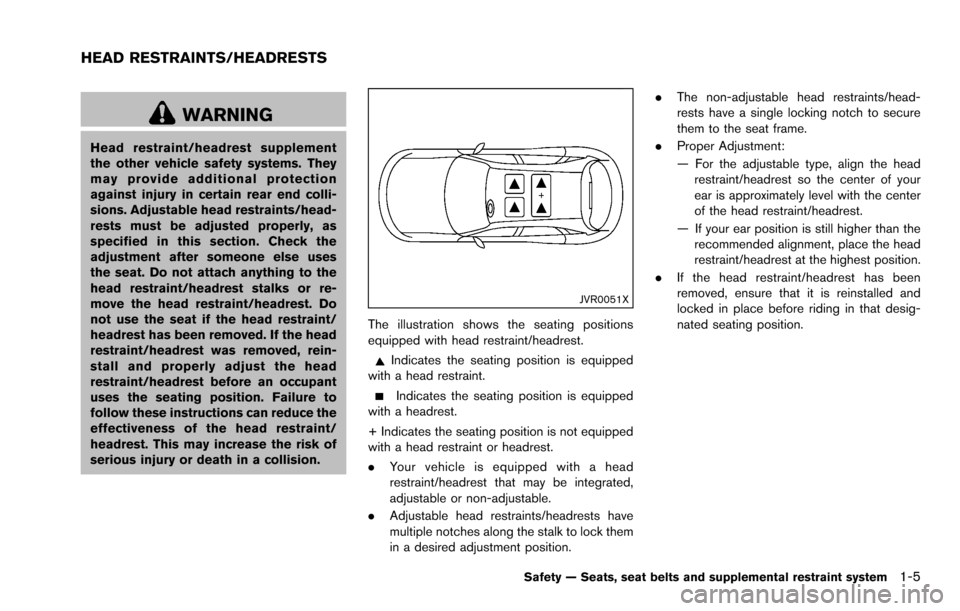
WARNING
Head restraint/headrest supplement
the other vehicle safety systems. They
may provide additional protection
against injury in certain rear end colli-
sions. Adjustable head restraints/head-
rests must be adjusted properly, as
specified in this section. Check the
adjustment after someone else uses
the seat. Do not attach anything to the
head restraint/headrest stalks or re-
move the head restraint/headrest. Do
not use the seat if the head restraint/
headrest has been removed. If the head
restraint/headrest was removed, rein-
stall and properly adjust the head
restraint/headrest before an occupant
uses the seating position. Failure to
follow these instructions can reduce the
effectiveness of the head restraint/
headrest. This may increase the risk of
serious injury or death in a collision.
JVR0051X
The illustration shows the seating positions
equipped with head restraint/headrest.
Indicates the seating position is equipped
with a head restraint.
Indicates the seating position is equipped
with a headrest.
+ Indicates the seating position is not equipped
with a head restraint or headrest.
. Your vehicle is equipped with a head
restraint/headrest that may be integrated,
adjustable or non-adjustable.
. Adjustable head restraints/headrests have
multiple notches along the stalk to lock them
in a desired adjustment position. .
The non-adjustable head restraints/head-
rests have a single locking notch to secure
them to the seat frame.
. Proper Adjustment:
— For the adjustable type, align the head
restraint/headrest so the center of your
ear is approximately level with the center
of the head restraint/headrest.
— If your ear position is still higher than the recommended alignment, place the head
restraint/headrest at the highest position.
. If the head restraint/headrest has been
removed, ensure that it is reinstalled and
locked in place before riding in that desig-
nated seating position.
Safety — Seats, seat belts and supplemental restraint system1-5
HEAD RESTRAINTS/HEADRESTS
Page 29 of 322
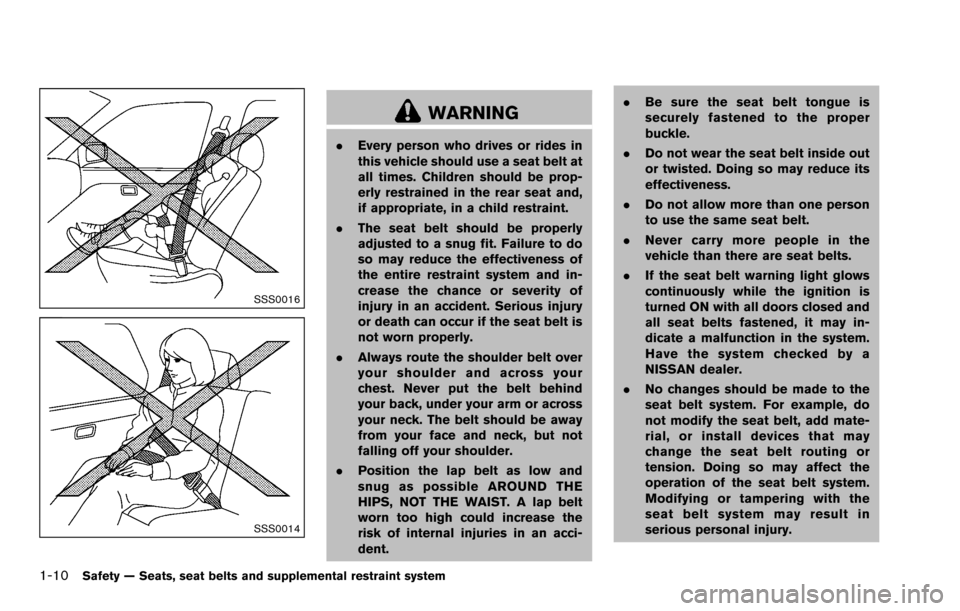
1-10Safety — Seats, seat belts and supplemental restraint system
SSS0016
SSS0014
WARNING
.Every person who drives or rides in
this vehicle should use a seat belt at
all times. Children should be prop-
erly restrained in the rear seat and,
if appropriate, in a child restraint.
. The seat belt should be properly
adjusted to a snug fit. Failure to do
so may reduce the effectiveness of
the entire restraint system and in-
crease the chance or severity of
injury in an accident. Serious injury
or death can occur if the seat belt is
not worn properly.
. Always route the shoulder belt over
your shoulder and across your
chest. Never put the belt behind
your back, under your arm or across
your neck. The belt should be away
from your face and neck, but not
falling off your shoulder.
. Position the lap belt as low and
snug as possible AROUND THE
HIPS, NOT THE WAIST. A lap belt
worn too high could increase the
risk of internal injuries in an acci-
dent. .
Be sure the seat belt tongue is
securely fastened to the proper
buckle.
. Do not wear the seat belt inside out
or twisted. Doing so may reduce its
effectiveness.
. Do not allow more than one person
to use the same seat belt.
. Never carry more people in the
vehicle than there are seat belts.
. If the seat belt warning light glows
continuously while the ignition is
turned ON with all doors closed and
all seat belts fastened, it may in-
dicate a malfunction in the system.
Have the system checked by a
NISSAN dealer.
. No changes should be made to the
seat belt system. For example, do
not modify the seat belt, add mate-
rial, or install devices that may
change the seat belt routing or
tension. Doing so may affect the
operation of the seat belt system.
Modifying or tampering with the
seat belt system may result in
serious personal injury.